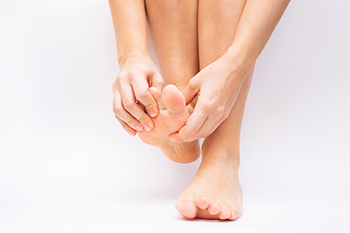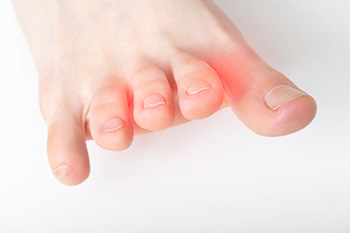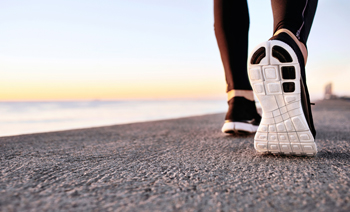Items filtered by date: August 2022
Arthritis in the Big Toe

The big toe plays an important role in our ability to walk and remain balanced. The place where the big toe connects to the foot is called the metatarsophalangeal joint (MTP). This joint, like many others in the body, is often the target of osteoarthritis because it gets a lot of wear and tear. Symptoms include pain (especially while active), stiffness, swelling, and a shifting of weight when you walk (change in gait). Occasionally, the big toe pushes toward the other toes, forming a bunion. Stiffness in the joint can result in a difficulty walking, which then can lead to the formation of calluses, corns, and hammertoes. The risk of developing osteoarthritis increases as you age, but other factors such as genetics, obesity, and prior joint injury can contribute to it. As with any progressive disease, osteoarthritis in the big toe can only become worse. Getting treatment from a podiatrist as early as possible is a good idea. X-rays can often detect the extent of the damage to the MTP joint and help the doctor to determine treatment options. Among them are certain prescription medications, changes in footwear, and in severe cases, surgery. For more information on osteoarthritis of the big toe, please consult a podiatrist.
Toe pain can disrupt your daily activities. If you have any concerns, contact one of our podiatrists of Bruening Foot & Ankle. Our doctors can provide the care you need to keep you pain-free and on your feet.
What Causes Toe Pain?
Most severe toe pain is caused due to a sports injury, trauma from dropping something heavy on the toe, or bumping into something rigid. Other problems can develop over time for various reasons.
Toe pain can be caused by one or more ailments. The most common include:
- Trauma
- Sports injury
- Wearing shoes that are too tight
- Arthritis
- Gout
- Corns and calluses
- Hammertoe
- Bunions
- Blisters
- Ingrown toenails
- Sprains
- Fractures (broken bones)
- Dislocations
When to See a Podiatrist
- Severe pain
- Persistent pain that lasts more than a week
- Signs of infection
- Continued swelling
- Pain that prevents walking
Diagnosis
In many cases the cause of toe pain is obvious, but in others, a podiatrist may want to use more advanced methods to determine the problem. These can range from simple visual inspections and sensation tests to X-rays and MRI scans. Prior medical history, family medical history, and any recent physical traumatic events will all be taken into consideration for a proper diagnosis.
Treatment
Treatments for toe pain and injuries vary and may include shoe inserts, padding, taping, medicines, injections, and in some cases, surgery. If you believe that you have broken a toe, please see a podiatrist as soon as possible.
If you have any questions please feel free to contact our offices located in Covina and Alta Loma, CA . We offer the newest diagnostic tools and technology to treat your foot and ankle needs.
What is Morton’s Neuroma, and How Can Symptoms Be Relieved?

Morton’s neuroma is a foot condition that affects the nerves generally between the third and fourth toes. It is defined as a thickening of the tissue surrounding the toes, and it can cause severe pain and discomfort. It can be thought of as a lump of scar tissue in the foot. It may gradually develop from frequently wearing high heels, or if there has been a foot injury. The nerve can become irritated, and there may be a tingling sensation, or a loss of feeling. Some patients feel the pain in the ball of their foot, and this often becomes worse as time progresses. Specific imaging tests may be performed to determine a correct diagnosis, and the foot may be manipulated to reproduce the symptoms. Relief can come from changing the shoes that are worn, and it may help to wear custom-made orthotics which may lessen the pressure from the neuroma. Additionally, it is beneficial to temporarily stop any physical activity, and this may help to reduce the discomfort. If you feel you have developed Morton’s neuroma, it is advised that you seek the counsel of a podiatrist who can guide you toward correct treatment options.
Morton’s neuroma is a very uncomfortable condition to live with. If you think you have Morton’s neuroma, contact one of our podiatrists of Bruening Foot & Ankle. Our doctors will attend to all of your foot care needs and answer any of your related questions.
Morton’s Neuroma
Morton's neuroma is a painful foot condition that commonly affects the areas between the second and third or third and fourth toe, although other areas of the foot are also susceptible. Morton’s neuroma is caused by an inflamed nerve in the foot that is being squeezed and aggravated by surrounding bones.
What Increases the Chances of Having Morton’s Neuroma?
- Ill-fitting high heels or shoes that add pressure to the toe or foot
- Jogging, running or any sport that involves constant impact to the foot
- Flat feet, bunions, and any other foot deformities
Morton’s neuroma is a very treatable condition. Orthotics and shoe inserts can often be used to alleviate the pain on the forefront of the feet. In more severe cases, corticosteroids can also be prescribed. In order to figure out the best treatment for your neuroma, it’s recommended to seek the care of a podiatrist who can diagnose your condition and provide different treatment options.
If you have any questions, please feel free to contact our offices located in Covina and Alta Loma, CA . We offer the newest diagnostic and treatment technologies for all your foot care needs.
Heel Spurs: An Often Overlooked Heel Condition

The plantar fascia tissue attaches to the heel bone and stretches out to connect with the toes. When this band of tissue gets excessively and repeatedly stretched, it can stress the heel bone and tear its lining. This type of wear and tear on the heel bone can prompt a response in the body where calcium deposits build up over time creating spurs on the bone that can grow up to half an inch. Heel spurs may or may not be painful. They may go undiagnosed or overlooked because they can occur in tandem with the inflammatory condition known as plantar fasciitis. If your heel spurs are symptomatic, they may create sharp pain, heat, tenderness, and inflammation in the heel. People who are obese or who have osteoarthritis are more prone to developing heel spurs. Older adults and those who wear improper footwear are also more at risk. If you are experiencing heel pain or believe you may have heel spurs, make an appointment with a podiatrist who may need an X-ray to diagnose your heel spurs. Once diagnosed, your heel spur may be treated with rest, cold compresses, anti-inflammatory injections, pain medication, physical therapy, stretching, and more.
Heel spurs can be incredibly painful and sometimes may make you unable to participate in physical activities. To get medical care for your heel spurs, contact one of our podiatrists from Bruening Foot & Ankle. Our doctors will do everything possible to treat your condition.
Heels Spurs
Heel spurs are formed by calcium deposits on the back of the foot where the heel is. This can also be caused by small fragments of bone breaking off one section of the foot, attaching onto the back of the foot. Heel spurs can also be bone growth on the back of the foot and may grow in the direction of the arch of the foot.
Older individuals usually suffer from heel spurs and pain sometimes intensifies with age. One of the main condition's spurs are related to is plantar fasciitis.
Pain
The pain associated with spurs is often because of weight placed on the feet. When someone is walking, their entire weight is concentrated on the feet. Bone spurs then have the tendency to affect other bones and tissues around the foot. As the pain continues, the feet will become tender and sensitive over time.
Treatments
There are many ways to treat heel spurs. If one is suffering from heel spurs in conjunction with pain, there are several methods for healing. Medication, surgery, and herbal care are some options.
If you have any questions feel free to contact our offices located in Covina and Alta Loma, CA . We offer the latest in diagnostic and treatment technology to meet your needs.
Are You Suffering From Ingrown Toenails?
How to Choose a Running Shoe

There are several types of running shoes and it can be a daunting task to choose the right type. It generally depends on the style of running that is preferred, whether it is low or high mileage. Additionally, deciding what surface to run on can determine what type of shoe is correct for you. People who enjoy running on pavements may want to choose road shoes to run in. These are adequate in absorbing shock that is helpful in minimizing injury. Trail shoes are suggested for running through soft and muddy trails because of the deep treads they have which can help to support the ankle. Many people choose to have their gait or walking style analyzed and this is important in knowing where the foot strikes the ground, and how far it rolls inward. It is suggested to wear the socks that would be worn with the shoes before purchasing them as this can have an impact on how the shoes will fit. Marathon runners will have a different type of shoe than short distance runners that will typically be more flexible. If you have questions about what type of running shoes to buy and how they can affect your feet, please schedule an appointment with a podiatrist.
You should always make sure your running shoes fit properly in order to avoid injury. For more information, contact one of our podiatrists from Bruening Foot & Ankle. Our doctors can provide the care you need to keep you pain-free and on your feet.
Choosing the Right Running Shoe for Your Foot Type
Improper shoe sizing can cause a myriad of problems for your feet. Shoes that don’t fit you properly can lead to muscular imbalances in your body, which can result in foot, knee, and hip injuries.
Tips for Finding the Right Running Shoe
- Make sure you have a thumb’s width of wiggle room between the end of your longest toe and the front of the shoe.
- There should be little to no slipping at the heel
- Don’t assume your size in one shoe brand will be your size in another
- Do not lace up your shoes too tightly
- Walk around in the store with your new shoes before you buy them
If you have any questions please feel free to contact our our offices located in Covina and Alta Loma, CA . We offer the newest diagnostic and treatment technologies for all your foot and ankle needs.
How Being Overweight Affects the Feet

It is common knowledge that being overweight can lead to heart problems and other maladies. In addition, extra body weight can also be the cause of problems with your feet, ankles, knees, and hips. Research shows that the risk of a broken ankle or knee injury increases when a person's body mass index (BMI) is greater than 30-35. Being overweight puts extra pressure on the bones in the feet and ankles, which are not built to carry the amount of stress extra weight causes. Your gait, or the way you walk, may be altered. This in turn affects the legs, knees and hips, which can inhibit your ability to exercise or carry out daily activities. Perhaps the greatest risk of obesity is the onset of diabetes and/or high blood pressure, as well as the development of bunions, plantar fasciitis and other foot deformities. Paying attention to a healthy diet and exercising regularly can be the first steps in eliminating foot pain and other problems. If you are overweight and experience frequent or chronic foot pain, or if your ankles seem unstable, please consult with a podiatrist who can offer guidance and treatment options.
Obesity has become very problematic at this point in time and can have extremely negative effects on the feet. If you’re an obese individual and are concerned about your feet, contact one of our podiatrists from Bruening Foot & Ankle. Our doctors can provide the care you need to keep you pain-free and on your feet.
Obesity and Your Feet
Since your feet are what support your entire weight when standing, any additional weight can result in pain and swelling. Being overweight is one of the main contributors to foot complications.
Problems & Complications
Extra Weight – Even putting on just a few extra pounds could create serious complications for your feet. As your weight increases, your balance and body will shift, creating new stresses on your feet. This uneven weight distribution can cause pain, even while doing the simplest tasks, such as walking.
Diabetes – People who are overweight are at serious risk of developing type-2 diabetes, which has a drastic impact on the health of your feet. As you get older, your diabetes might worsen, which could lead to loss of feeling in your feet, sores, and bruises. You could also become more prone to various infections.
Plantar fasciitis – Pressure and stress that is placed on muscles, joints, and tendons can trigger plantar fasciitis, which is an inflammation of tissue that forms along the bottom of the foot.
If you have any questions please feel free to contact our offices located in Covina and Alta Loma, CA . We offer the newest diagnostic and treatment technologies for all your foot and ankle needs.

